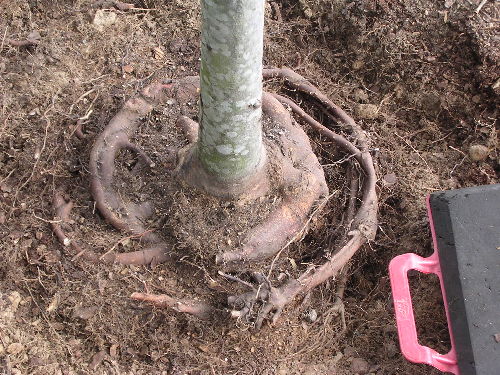There's a disturbing trend out there in the world of declining trees in the landscape - stem girdling roots. These are roots that are strangling trees by wrapping around the buried part of the trunk. Sometimes you can see them, but more often than not you need to remove soil from the base of the tree before they're visible. Girdling roots make it difficult for nutrients and water to flow upward - they're like a tourniquet. The tree grows very slowly, it goes into premature decline, and the base of the trunk is weakened and can snap in a storm.

What causes girdling roots? Research over the last decade has shown that problems often originate in the nursery. Here's why: Most trees begin their lives in large nurseries that specialize in growing "liners" - trees of about 1" in caliper. Liners are then sold to regional nurseries where they're grown on to the sizes that we buy at our wholesale nurseries. Years ago, the liners were raised in fields and transplanted with bare roots. The grower could easily examine the roots and plant the tree properly with the main roots and trunk flare close to the surface of the soil. Now, containers are used at various stages of the growing process - field-grown trees are often started in containers. When a tree root reaches the wall of a container, it bends in a new direction to keep growing. Usually, this bend forces the root to grow in a circle along the container wall.
An additional common problem is when the trunk flare is buried under inches of soil. As lateral roots grow out of the buried part of the trunk, they can encircle the stem close to the surface. In field-grown trees, cultivation equipment used for weed management pushes soil against the trunk. With containers, roots may be buried when the root ball from the previous container is set too low and potting mix is added to top off the container.
What can we do?
The key is try your best not to plant trees with ill-formed roots. That means inspecting field-grown trees in the nursery to find the depth and distribution of a few main roots. Using garden tools, carefully dig around the base of the tree to ensure that the following criteria are met:
- A minimum of 3 structural roots should be reasonably distributed around the trunk (reject a tree with structural roots only on one side)
- The root crown should not be more than 2 inches below the soil line
- The top 2 structural roots should not be more than 3 inches below the soil line when measured 4 inches away from the trunk. The top of the other structural root should not be more than 5 inches below the surface.
- The root system should be free of potentially stem-girdling roots above the root collar and main structural roots
This type of inspection is non-invasive and doesn't harm the tree. It often may require that burlap be unwrapped from around the tree trunk - you should do this anyway, because you need to see the root flare, if possible, and inspect the trunk for any damage or evidence of rot or insects. Your wholesale supplier should have no reason to object to this, especially if you explain what you're doing and why. If you're not allowed to inspect, my advice would be to find a different supplier.
For containerized trees the inspection process is more difficult. At the nursery, you should be able to determine that the tree has been grown in the container long enough for the root system to be able to hold the potting medium together - but not so long as to have roots that are matted or circling around the edge of the root mass. At planting time, be certain to shave all circling roots on the exterior of the root mass deep enough so that all the cut ends are roughly radial to the trunk. This may add a little time, but will contribute to the ability of the tree to become established.
Some practitioners don't use containerized trees at all. This is because the possibility exists that there have been circling roots that were not pruned away before the tree was transferred to a larger container. A given tree could then have three sets of circling roots if it has been up-potted three times. Each set is further embedded in the root mass, and it's very hard to figure out if they're there.
Planting bare-root trees bypasses all of these problems, since you can see the whole root mass and prune as needed. But transporting and planting bare-root is tricky - make sure you understand the issues before you try it.
